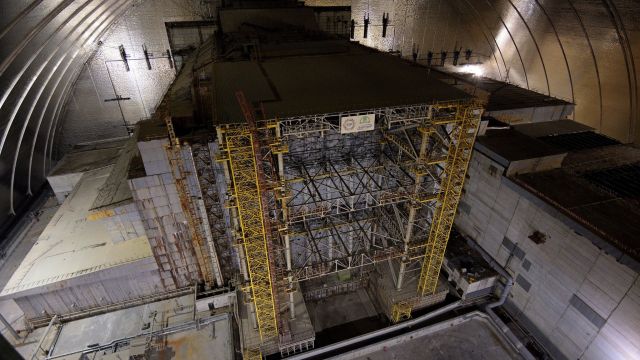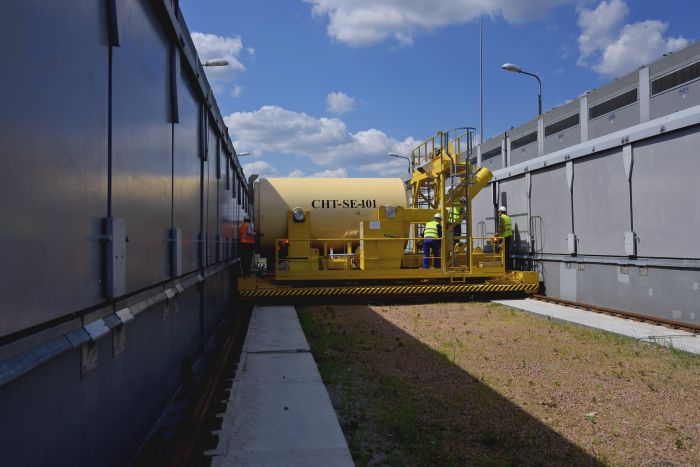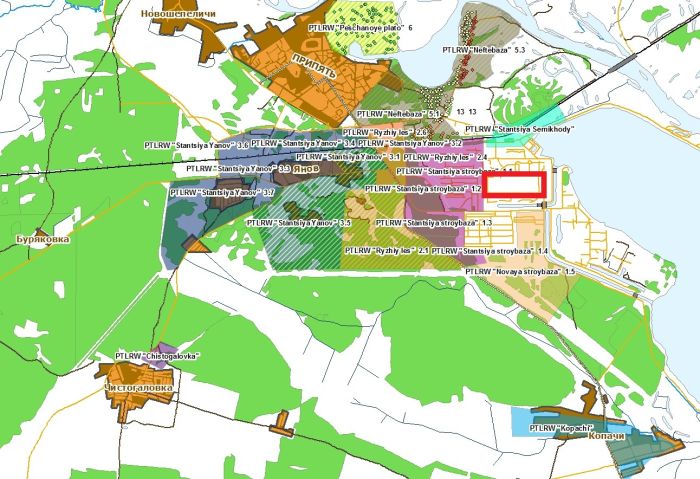
An anniversary in times of war
The 36th anniversary of the Chernobyl nuclear accident on 26 April is marked by the war in Ukraine. Since the invasion of Russian troops on Ukrainian territory on 24 February 2022, nuclear installations have also been directly or indirectly affected by the fighting - including the immediate area and the 30-km exclusion zone around the former Chernobyl nuclear power plant (NPP). In this article, we take a look at the situation on site since the beginning of the war. Furthermore, we take a look at the work that was carried out on the site of the NPP before the invasion began.
Situation on the plant site and in the exclusion zone since the beginning of the war
When Russian troops entered the exclusion zone at the end of February, the local dose rate at various measuring points within the 30-kilometre exclusion zone and on the NPP site increased by up to 30 times the usual values by 28 February 2022. This did not pose a risk to Germany. The Ukrainian supervisory authority attributed the increase to the fact that Russian military vehicles had stirred up dust containing radioactive substances stemming from the 1986 accident. A few days after the start of the invasion, the data from the MEDO monitoring network from the exclusion zone could no longer be accessed online, which made it difficult to immediately assess the radiological situation on site. Before the disconnection, however, the values had again somewhat decreased.
Due to the armed conflicts, the last connection of the site to the external power grid failed on 9 March. The facilities on the power plant site that depend on external power supply, such as the wet storage facility for spent fuel elements (the so-called ISF-1), had to be supplied by emergency diesel power for a long time until the power connection could be permanently restored on 14 March.
A major cause for concern over the past weeks has been the extremely stressful situation for the operating personnel at the power plant site. After almost four weeks of continuous duty, it was possible to replace them for the first time on 21 March. Both the Ukrainian supervisory authority and the IAEA had repeatedly pointed out the great psychological pressure the employees were under. In addition to the presence of Russian troops at the plant itself, contact with families and friends was hardly possible. On 24 March, it also became public that checkpoints in the town of Slavutych were under fire. Most of the NPP's employees live in the town. By 20 April 2022, only two personnel changes had taken place (on 21 March and 10 April 2022). From 21 April 2022, the regular replacement of the operating personnel for the Chernobyl NPP could be resumed.
On 23 March, the IAEA, among others, provided information about forest and wildland fires that had broken out within the exclusion zone. Fires of this kind have frequently been observed there at this time of year. However, based on experience from previous years, among other things, a risk to people on site and beyond - for example from radioactive particles that can be released when plants and soil burn - was not to be expected.
Following the withdrawal of Russian troops from the NPP site and the exclusion zone on 31 March, the IAEA is planning an expert mission to the site starting on 26 April. The mission will include radiological assessments, identification of equipment needs, and repair of radiological monitoring systems. Finally, on 19 April, the IAEA also informed about the restoration of a direct telephone link between the authority and the plant. This link had been interrupted since 10 March.
More information on current developments at the Chernobyl site and at Ukraine's other nuclear installations can be found on our Chernobyl info page and in our newsblog on the situation in Ukraine (both in German language).
Work on the plant site before the outbreak of war
Until the invasion of Russian troops, work on the site of the Chernobyl power plant was carried out as usual. GRS experts are involved in many of the - also internationally funded - projects. Since 1986, GRS has been dealing with the Chernobyl nuclear accident and its consequences. This includes both the scientific reappraisal of the accident and the support of the local authorities.
For example, GRS, together with the Ukrainian expert organisation SSTC NRS, is carrying out scientific work on the assessment of hazards in the Sarcophagus system covered by the New Safe Confinement (NSC). Currently, the activities of GRS and SSTC NRS are focused on the influence of the fuel-containing materials contained therein on the radiological situation, in particular with regard to airborne activity.
Another example of this cooperation is the maintenance and updating of a database used i.a. to record the radiological situation at the site.
Acquisition of radiological data
Since 2006, GRS has been developing the "Shelter Safety Status Database" (SSSDB) together with Ukrainian scientists. The database collects data on the radiological situation on site, which are collected in cooperation with Ukrainian experts. For example, more than 1,000 forest fires from the period 1993 to 2021 are recorded in the database. It also records the location and activity of so-called "waste dumps" (see Figure 1). Many of these waste dumps were set up provisionally in the area around the NPP immediately after the nuclear accident. Since 2021, data on wildlife contamination has also been recorded.
The SSSDB also records the data from the NSMS (Nuclear Safety Monitoring System) for monitoring nuclear safety inside the Sarcophagus.
The data collected in the Sarcophagus include values for neutron flux density and local dose rate, which are measured by the NSMS at 19 monitoring points. Long-term observation also makes it possible to look at the development of these values. For example, since 2016, an increase in neutron flux density has been measured in the vicinity of Room 305/2, which contains so-called corium (remnants of the reactor core that melted during the accident). The measured radiation in Room 305/2 has increased by a factor of two to three in four years (2016-2020), but is well below the permissible limits.
The possibility of recriticality and the conditions required for this were also discussed again and again. The increase in neutron flux density is a critical safety parameter that must be monitored. So far, it has not been possible to clearly determine the reason for the increase in this specific room, among other things because the room cannot be entered due to the high levels of radiation prevailing there. One possible explanation discussed, for example, is that after the installation of the NSC above the Sarcophagus, rainwater from outside no longer reached the room with the fuel-containing material. The water that was still present at that time could have partially evaporated and subsequently reached exactly the quantity to serve as a moderator for starting a chain reaction. Another possible explanation discussed is the decreasing shielding function of the water present in the room during drying. As a result, the probability of detectable neutrons leaving the room would increase, causing an apparent increase in emitted neutrons in the measured signal.
More recent measured data for Room 305/2 inside the Sarcophagus are currently not available to GRS. According to Ukrainian scientists, however, the measured values have not increased any further. Despite the significantly increased neutron radiation, the current situation is considered to be stable and harmless.
New Safe Confinement (NSC)
In the same year as the accident, a steel and concrete structure - the Sarcophagus - was erected over the destroyed reactor. Some of the remains of the destroyed reactor building were used in the construction of the Sarcophagus, as far as they could still be used after the accident. The Sarcophagus was thus designed from the outset as a temporary solution for a limited period of time. A permanent solution was to be realised at a later date. A collapse of the Sarcophagus - especially in extreme weather conditions or in the event of an earthquake - could not be ruled out. As the work for a new safe confinement had been postponed, important parts of the Sarcophagus were first stabilised until 2008. It was assumed that the remaining unstable parts of the Sarcophagus would have to be dismantled by 2023. Until the new safe confinement (NSC) was pushed over the Sarcophagus, there was therefore a risk that radioactive substances could be released into the environment if the Sarcophagus collapsed.
The NSC was completed in the second quarter of 2019. In July 2019, the NOVARKA consortium officially handed over the NSC to the Chernobyl NPP. This was followed by two years of operation of the entire plant in the warranty phase under regular operating conditions.
In August 2021, regular operation of the NSC started after the nuclear regulatory authority SNRIU granted the operating licence. The shell surrounds the Sarcophagus with the power plant ruins of the destroyed Unit 4. Initial work and planning to dismantle unstable structures of the Sarcophagus, but also visual and instrumental inspections, radiation measurements and surveys have been started, but they are currently suspended due to the present situation. An important licensing condition for the operation of the NSC/Sarcophagus is that the unstable structures of the Sarcophagus be dismantled by the end of 2023. Under the current circumstances, however, this schedule will in all likelihood be significantly delayed.
Spent fuel and other radioactive waste
At the end of April last year, the nuclear licence for the operation of the new long-term interim storage facility for spent fuel elements of the Chernobyl NPP (ISF-2) was granted. The dry storage facility is designed for a period of 100 years and is to accommodate the spent fuel elements of Units 1-3 that were previously stored in the wet storage facility ISF-1. As of 22 January 2022, 1,698 spent fuel assemblies have been transferred from ISF-1 to ISF-2. However, it will take at least seven years until all 21,370 fuel assemblies will have been transferred.

The Liquid Radwaste Treatment Plant (LRTP) was also granted an official operating licence in May 2021. Since then, the liquid waste produced during the operation of the Chernobyl NPP has been treated there on an industrial scale. During 2021, more than 4,000 containers of treated liquid wastewater were produced. Most recently, work has been carried out on the treatment process, among other things with the aim of increasing the efficiency of the plant.
At the end of 2021, the final commissioning phase, the so-called "hot tests" for the ICSRM (Industrial complex for solid radioactive waste management) also started. During this phase, the plant is operated in a mode that comes as close as possible to future conditions. For example, radioactive materials are already being processed in this phase on a test basis. In the ICSRM, solid radioactive waste from the decommissioning of the Chernobyl power plant is to be processed and packaged in such a way that it can be transported to a repository.
In 2021, the construction of the Central Interim Storage Facility (CSFSF) for spent fuel from the Rivne, South Ukraine and Khmelnytsky NPPs was also completed near the Chernobyl NPP. The Zaporizhzhya NPP site has its own interim storage facility. However, as yet, no containers with spent fuel elements have been stored at the CSFSF. On the one hand, this is due to delays in the completion of the railway line needed for the transports from the NPP sites to Chernobyl. On the other hand, approvals from the nuclear supervisory authority were still pending.
